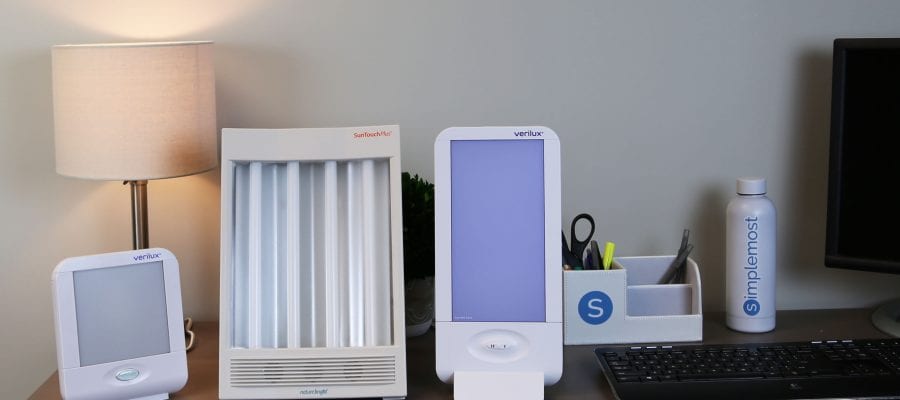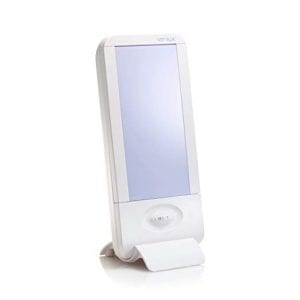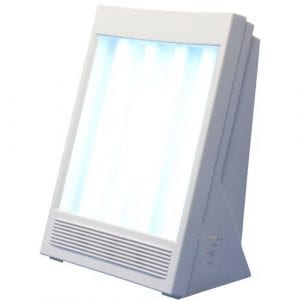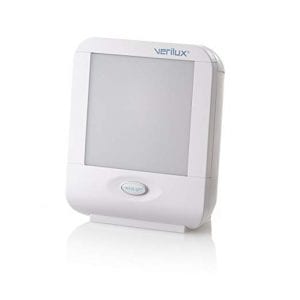The Best Light Therapy Lamp
We looked at the top 9 Light Therapy Lamps and dug through the reviews from 99 of the most popular review sites including and more. The result is a ranking of the best Light Therapy Lamps.

Our Review Process
Don't Waste Your Money is focused on helping you make the best purchasing decision. Our team of experts spends hundreds of hours analyzing, testing, and researching products so you don't have to. Learn more.
Our Picks For The Top Light Therapy Lamps
The Verilux HappyLight Full Spectrum Therapy Lamp offers the best value for those looking for an affordable light therapy option. This model has special settings for the way that you want to use it in your life. The easy assembly and fuss-free adjustability also make this lamp a great purchase. In our testing, we liked that it came with two differ...
Lots of SettingsAn affordable light therapy lamp that's easy to assemble and adjust.
In our testing, we loved the timer and the curved lense of this light therapy lamp, which emits 17,000 Kelvin UV-free light. This lamp also doubles as an air purifier, emitting negative ions to help improve your mood.
Negative IonsA light therapy lamp that emits negative ions and doubles as an air purifier.
We love how small and portable this light therapy lamp is. Plus, we found it incredibly easy to operate. The 5,000 lux moderate UV filtered rays will help improve your mood and reset your body clock for better sleep.
Portable LampSmall, portable and effective.
Buying Guide
Do you get serious wintertime blues? It may be more than that. Seasonal Affective Disorder, also known as SAD, is a psychological disorder that affects roughly 5% of people just in the United States. This disorder is similar to depression with its symptoms. You might feel extreme tiredness, anti-social tendencies, sleeplessness, agitation, guilt over menial things and even despair.
Its typical onset is around daylight savings time in the fall and usually lasts through the winter. For some individuals, this can be as long as five months. It can be accompanied with weight gain and appetite changes. If you notice a combination of these things in your lifestyle during the winter months, do not hesitate to reach out to your doctor. It can take up to three years to diagnose the mild cases of SAD, so don’t wait too long to resolve these symptoms.
Seasonal Affective Disorder is diagnosed using a series of tests. You will start with a physical exam to rule out other health factors that could contribute to depression. Lab tests will be run to check your blood and usually a thyroid test as well. A psychological evaluation is another common exam to find the diagnosis. Once diagnosed, it is important for doctors to assess the extent of the disorder and see if there are any other depression diagnoses in the patient. This will help to find the right treatment for the patient.
Although there are varying degrees of treatments including medications, one very successful treatment in patients displaying symptoms of SAD (not necessarily for patients with other types of depression or mental health disorders) is light therapy. Patients are educated on the use of a light therapy lamp in their daily routine. These lamps come in multiple styles and can really help patients suffering from SAD or milder forms of the winter blues.
A light therapy lamp works by emitting rays that are very similar to UV rays emitted by the sun. The light stimulates certain chemicals in the brain, such as serotonin and melatonin, to help with mood and improve sleep cycles. Patients are instructed to sit by the lamp for a suggested amount of time and/or during a specific time of day. The light must enter the eyes without directly looking at the lamp itself. This can even be achieved just by letting the light hit your skin. Refer to your doctor for instructions.
There is a combination of things to remember for a light therapy lamp to effectively work: intensity, duration and timing. There is a range of light intensities for the lamps. However, 10,000-lux lights are the most popular. The biggest concern with this intensity is to be sure you get a lamp that blocks 100% of the UV rays, such as the Verilux HappyLight Full-Size Lamp.
The proscribed duration is typically 30 minutes with a lamp that has 10,000-lux light but for a weaker lamp, you may need a longer session. The timing is the third factor, and most doctors recommend timing your sessions in the early morning. Because the light therapy lamps mimic the sun rising, they can create a normal circadian rhythm if used regularly during the wintertime. A doctor might recommend other times as well, depending on your diagnosis.
Consumers can choose from several different types of light therapy lamps. There are dawn simulators that come in two types: naturalistic dawn and sigmoidal-shaped dawn. The lightboxes are the most common light therapy lamps. Natural spectrum light bulbs are another way to help get your circadian rhythm back on track. Bluewave technology also suppresses melatonin so you don’t feel that extreme fatigue. You can also choose to use a bright light sun visors which is a hat with a built-in lightbox. Doctors don’t frequently suggest using these because it places the light very close to your eyes so always use them with caution.
A light on a timer is a simple way to help get your circadian rhythm back on track. You can easily find a lamp with a timer and set it to act as a superficial dawn for everyday use, however, this method is not extremely effective as it is a sudden switch of the light instead of a gradual increase in light like a normal sunrise. All of these light therapy lamps and treatments have been proven to help with SAD and even patients with low Vitamin D and mild wintertime blues. Find the one that works best for you by relying on fellow consumer reviews and suggestions from your physician.
Why we recommend these light therapy lamps?
Products Considered
Products Analyzed
Expert Reviews Included
User Opinions Analyzed
What to Look For
- The most effective light therapy lamps are going to be at the 10,000 lux intensity.
- Look for a light that offers bright white light without the damaging UV rays. (99% or more of the UV rays should be filtered out.)
- The light therapy lamp or box should be positioned around eye level or a little higher, so you get the feeling you are out in the full sunshine of the summer.
- Roughly two feet from your eyes is said to be the magic positioning of the lamp for the best effects. (This is if you have a 10,000 lux light. If you have a weaker lamp, sit closer.)
- Placement should be off to your right or left, not directly in front of your face.
- Morning has been found to be the best time to use the light therapy lamps. You can use it from 20 minutes to up to an hour. This doesn’t mean that you have to be sitting in front of it the entire time — grab a coffee, breakfast or even do your makeup routine while being nearby.
- Patients who do the therapy every day have the most success, so add it to your daily routine.
- Always tell your physician if you are using one so they can check any medications you may be using that could make your skin photosensitive (i.e. antibiotics).
- Be sure to take notice of mood and energy levels as the weeks go by after starting it. Most see noticeable improvement by week two.
You May Also Enjoy Our Other Reviews
- Robotic Vacuum
- Cordless Vacuums
- Air Mattress
- Drone
- Electric Razor
- Convertible Car Seat
- Infant Car Seat
- Dry Dog Food
- Carpet Cleaners
- Air Fryers
- Laptops
- Home Printers
- Wireless Router
- Streaming Device
- Electric Pressure Cooker
- Chromebook
- Television
- Digital Camera To Capture Special Moments On The Fly
- Smartwatch
- Upright Vacuum





